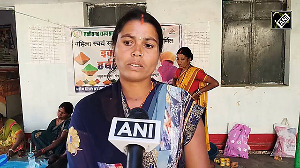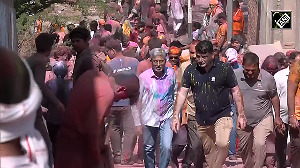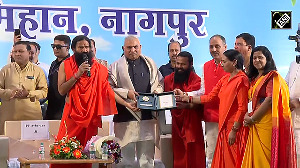Farmers in a remote village in Honavar, 600 km away from Bangalore, are using ATM machines to open a bank account. Believe us - it's true.
An ATM machine loaded on a van winds its way through the dusty roads of over five villages offering 22000-odd farmers perhaps their first experience with a bank - they can open an account, request for a loan and be able to deposit as well as withdraw cash at will in the near future.
The ATM machine is linked wirelessly through Reliance Infocomm's network to the backend server of the participating bank, which includes Syndicate Bank and State Bank of India. The software on the ATM is simple - in regional languages and very easy to decipher.
Says S S Satchidananda, professor in Indian Institute of Information Technology who piloted the project with funds from a consortium lead by Microsoft: "What we wanted to demonstrate is a cost saving solution for banks that are seeking to expand their rural reach but have no other choice but to set up a branch which is expensive and unviable".
For the last few years state governments, NGOs and some pioneering companies have tried to crack the technology barrier - by developing pilot projects to showcase the marvels of IT in a rural setting. The phenomenon is better known as "Bridging the Digital Divide".
The success of ITC's 6000 odd e-choupals covering over 35000 villages, has made many believe that this model can be made viable. Big boys are jumping onto the bandwagon - ranging from top IT companies, NGOs, technology providers and the government.
Need to scale up
The name of the game is clear: how to scale up and still be viable. Microsoft, for instance, has set up an ambitious target. It hopes to set up over 50000 broadband connected kiosks across villages covering over 50 per cent of the rural population in the next three years under the "Saksham" scheme. The company is funding NGOs as well as local companies with an undisclosed budget to make the project a reality.
Says Ranjivjit Singh, group director, consumer business: "In the last three months, we have rolled out over 300 kiosks and our studies have helped us build a self-sustaining model to enable the kiosk owner make money."
Not to be left behind, Intel recently joined the club announcing a new program "Jagruti" whereby it will offer PC makers an innovative platform developed exclusively for the rural market. Points out Bill M Sui, vice president, Intel: "The requirement for rural India is not cheap PCs, but PCs which work in that setting."
Intel has developed a rugged chassis to withstand dusty and extreme temperatures. It has also integrated a UPS as well as an AC\DC converter in the machine so that it can work on a car battery for six to eight hours, to tackle the lack of electricity in many villages. Moreover, it has also tied up with Microsoft in an "affordability alliance" which will look at partnerships to provide solutions for rural India.
Yes, the ministry of Information Technology has set up an ambitious target to set up one lakh "common services centres" across villages where e-governance services will be available by August 2007. It has tied up with ILFS to manage the roll-out with support from NGOs, ISPs and others. The government has also earmarked Rs 100 crore (Rs 1 billion) to fund this Mission 2007.
Local Indian companies who have pioneered the rural move, but have had problems of scaling up, are now embarking on an expansion spree. Jai Kisan - an NGO set up to introduce rural IT technology in Uttaranchal - is hoping to put up over 3000 Kisan Soochna Kendras (a digital hub) across the state.
But tobacco giant ITC is concentrating on creating a physical infrastructure to support the 6,000 e choupals - which are run by entrepreneurship-driven sanchalaks (organisers).
It is now creating a second tier of entrepreneurs by appointing up-sanchalaks (deputy organisers) in over 14000 villages (it has already appointed 15000) who would directly interact with the e-choupal owners. Also it is planning to set up over 50-choupal sagars, which will have hypermarkets, fuel stations, restaurants and even an educational service centre.
Says ITC's S Sivakumar, chief executive, international business division: "Till date, the sanchalaks were looking after six villages. We will soon have a digital infrastructure here in these villages too once more low cost communication solutions are available".
Chennai-based n-Logue Communications - part of the Telnet group, which was floated by professors in IIT Chennai, wants to replicate the PCO model to increase per capita incomes in rural India. It has already rolled out over 2500 kiosks across the country using C-ordect technology (wireless and local loop) to provide broadband connectivity to the villages.
Says Ashok Jhunjhunwala, who leads the Telnet group: "Our aim is to replicate the PCO model in rural India so that we can double the rural per capita GDP through IT. We want to set up a kiosk within 500 metres of everyone's home".
The model
Ensuring a connected kiosk model as a viable unit is not an easy task. That is why despite all the noise, there are not more than 13000 connected kiosks across the country (a large chunk of which is run by ITC's e-choupal). Jhunjhunwala admits that out of the 2500 kiosks that they have installed, only one-third works regularly.
Microsoft, for instance, undertook a study of over 350 kiosks, involving 4000 users in six states to understand user habits, which could throw up a viable model. Singh says the study threw up some interesting insights: kiosks, which only offered e-governance services (like registration of life and death, land records etc) were unable to sustain themselves very long.
The reason was simple: while 70 per cent of the revenues when the kiosk was launched came from e-governance, in six months it dropped to 20 per cent. So there was need for offering more comprehensive services in the kiosk for farmers to come in.
That is what Microsoft is doing. Says Singh: "Our approach is to bring different kinds of offline as well as online services together to make the kiosk viable."
The company has developed educational content online for children in local languages, which is available for a subscription of Rs 50 to Rs 100 a month. A printer and software for desktop publishing ensures that you can publish marriage or invitation cards or even a CV for a nominal Rs 10 to Rs 12 a piece.
And as PCs our loaded with Windows Media Player - many local kiosks owners have converted themselves into mini movie halls - offering movie shows at a nominal Rs 2-3 a show.
How does Microsoft ensure that the model is viable? Take, for instance, its tie up with Dhristee - an NGO, which has perhaps the cheapest-priced kiosk model. Kiosks are not cheap - one connected with a VSAT (Very Small Aperture Terminal), battery pack and printer, requires an investment of over Rs 70000.
The method is straightforward: the entrepreneurs have to pay Rs 20000 upfront. The rest comes from bank loans. Kiosks owners need to pay about Rs 1666 per month to pay off the loan but Drishtee offers them a minimum income guarantee of Rs 3000 a month.
Says Singh: "Our experience has shown that the entrepreneur is cash positive within the first two to three months." He points out that an average in a village of 5000 homes at least 20 people go to the kiosk everyday - and that is enough to break even and make money.
Microsoft of course funds Dhritsi lumpsum or with software support - which can be used to subsidise the overall investment, reduce his upfront cost, or his loan burden depending on individual needs.
There are other models too. And many are using innovative ways to generate revenues. Jai Kisan has, in fact, gone up-market by creating a "Kisan Soochna Kendra" in far-flung villages of Uttaranchal where road communication is not at its best.
The kendra has swanky styling - it is built with glazed tile floorings and equipped with the latest gizmos - laser printers and scanners and even a movie video camera and PCs connected by VSAT to the outer world. But is also costs money - an investment of a steep Rs 510,000.
Challenges
However, Sanjiv Sharma CEO of Jai Kisan.org says that despite the high cost, the model works. The owner of the Kendra - who is generally the gram pradhan puts Rs 25000 upfront. Jai Kisan (which gets funds from various agencies including companies like Microsoft) forks out Rs 40000, and banks fund the remaining portion.
Then you also get grants from the Khadi Vikas Industry Board - which use the kiosks for selling and promoting khadi products. To add to the viability, Jai Kisan guarantees the owner Rs 11,000 a month - which ensures that even after paying back the loan instalment (Rs 7500) he is making money.
The question, though, is how does Jaikisan afford to provide such a high level of guarantee? Well, simply put, it has innovative ways of getting in revenue.
The NGO for instance has roped in companies ranging from Pepsi to Coke to advertise by using the walls of the Kendra to sell their products.
Last year, it generated at an average Rs 5000 a month from selling advertising space. This year, it expects to hit Rs 11000 - which will take care of the minimum guarantee it offers the entrepreneur.
Secondly, the NGO has helped in floating Jai Kisan Foods (made out of farmer enraptures in the village), which sell farm products ranging from mangoes, herbs, medicinal plants through the Jaikisan portal to potential buyers - dispensing with the middle men. Already companies like Dabur are using the structure to buy medicinal plants directly from the farmers.
No doubt communication costs - through VSATs - are a key impediment in proliferation of the kiosk model. But as Jaikisan executives tell you, telephone connectivity of BSNL is unreliable (exchanges don't have power for days), private sector wireless connectivity is conspicuous by its absence - so there is no choice but to go for a VSAT even if it is not cheap.
Singh says if wireless connectivity was available, investment costs would fall by more than half and kiosk owners would have to pay only a monthly running cost of broadband connectivity. That, of course, remains the biggest challenge.
Solutions
Some are trying to get over the problem. Intel is pushing for Wimax as a cheaper solution but with its standards still not been fixed, this might be a while away. n-Louge, has deployed cordect (wireless and local loop) technology to bring in connectivity to the villages. And it charges between Rs 500 to Rs 1,000 monthly to ensure uninterrupted connectivity.
Says Jhunjunwala: "It is a much cheaper option virtually one sixth the cost of a VSAT connection. And the bandwidth which is not shared is far superior in quality than VSAT".
This would require a cluster of kiosks in a 25-50 kilometre area to justify the initial investment, which could be around Rs 40 lakh (after all you need to put in a couple of base stations around).
So Jhunjunwala says you need at least 200-300 kiosks to make it viable. At the moment with most companies spreading the kiosks over a larger geographical distance - it might not be the best option.
Agrees ITC's Sivakumar: "At the moment, only a VSAT is viable because you don't have the concentration of digital infrastructure in a small geographical distance".
But that is not deterring many companies and researchers to work out niche applications - which can be converted into a viable business model. One such area is banking. Mobile wireless ATMs-developed by IIIT Bangalore is one such solution.
Satchidananda points out that it costs a bank Rs 12 lakh (Rs 1.2 million) to set up a one- man branch in rural India, add in the huge running cost and it is unviable. But a mobile ATM operator invests Rs 12 lakh - and the infrastructure could be used for many villages, across talukas and many banks. So it is surely a cost-effective solution.
Satchidananda and his team are also working on creating a databank of village homes - information any bank, insurance company or even an FMCG would pay for - to process a loan application, an insurance claim or target a product.
The solution, underway in Karnataka, aims to encourage entrepreneurs to invest in a PDA and go to each home to collect information on topics like assets, livestock, crop patterns and income (they are paid for this collection of course by the bank or by the data center which wants to collect this information). This information is then sent wirelessly to data centers, which are owned by telcos.
Companies can tie up or pay for this information available with telcos. Says Satchidananda: "A bank can use this information to do individual credit rating and it can outsource the loan recovery work to the PDA owner. So it is a win win for both". Surely even telcos can make money-by selling this valuable information to potential clients.
Bridging the "digital divide" might not be as easy as it sounds. However, companies are taking the first steps to work out viable and scaleable models to make it a reality.Do you want to discuss stock tips? Do you know a hot one? Join the Stock Market Investments Discussion Group








 © 2025
© 2025